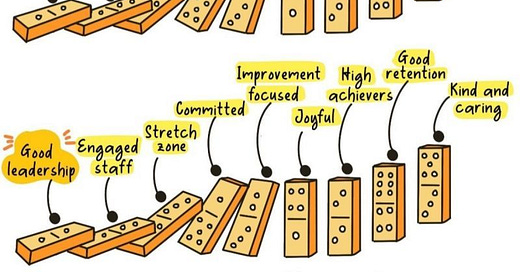This graphic is making the rounds on LinkedIn, where I originally re-posted it with a few thoughts.
I choose to re-post this graphic for two reasons.
First, to acknowledge the power of heuristics like this one in distilling essential truths. Leadership does indeed have both direct and knock-on impacts upon organizational health, performance, and enjoyment.
Second, to acknowledge the limitations of simplistic ideas like this one, which really only tell us the whole truth when we unpack them a bit more. There are three things this graphic doesn't say which are nonetheless true and important.
1. "Good leadership" is not enough. Leaders can be doing everything right and the organization can still underperform, have high turnover, and engender poor mental health in its teams ... if the structure and resources of the organization are wrong. Organizations need sufficient resources so that every day doesn't feel like an emergency. That kind of culture cannot be overcome by strong leadership. When people are serially overstretched, the aspirational pronouncements and vision-sharing of a strong leader can’t break through the mental noise created by immediacy and necessity. Perspective gives way to sheer focus on execution.
Believing a strong leader can overcome a bad organization is one of the more prevalent and abused misperceptions in modern workplaces. The tragedy it inflicts is two-fold … organizations still fail despite good leaders, and those leaders get frustrated by their inability to turn things around. They leave, and the entropy quickens.
2. The flip side is also true. "Bad leadership" is enough to ruin things even in an otherwise strong organization. With poor leadership, no matter how strong the culture and how smart the resource allocation, the organization is going to underperform, lose strong talent, and suffer from reduced enjoyment and positivity. When a bad leaders is inflicted on a good team, they feel their trust in the organization has been violated, and they begin to question how their executives can get the most important decision so wrong. Confidence crumbles from this, and can be nigh on impossible to rebuild.
3. Even really strong organizations struggle to develop "kind and caring" cultures. There is a sort of "emotional intelligence sound barrier" most organizations struggle to break through, and this is a predictable outcome of the world's most successful and leading business cultures spending many decades governed by bureaucratic and modernist management ideas which tend to mistake kindness as weakness and caring team cultures as naive.
One of my favourite sentiments comes from Gen. James Mattis, who said "be polite, be professional, but have a plan to kill everyone you meet."
This is a militaristic way of saying leaders need to be kind, open, engaging, and able to connect well with others by default ... and they need to foster such behaviours in their teams. They must also be equipped to switch modes when needed and spot such moments accurately.
What I have seen more often is a default organization tone of exclusivity and unnecessary "power distance" between leaders and teams. Because many leaders wrongly believe that being empathetic compromises their ability to be tough later ... and because the behaviour of leaders sets the tone for teams ... most organizations lack enough empathy for people to truly connect, which must happen for the team to reach its best together.
Experience tells me people and teams who go out of their way to look "tough" ... are usually masking insecurities. So when I see a leader or team projecting "toughness" it only makes me dig deeper to find and excavate their weaknesses.
The trick is actually being tough when the moment is right, but being empathetic as a default.
Tony is an award-winning senior manager who has led teams of thousands of people in complex operations. The opinions expressed here are his own.






